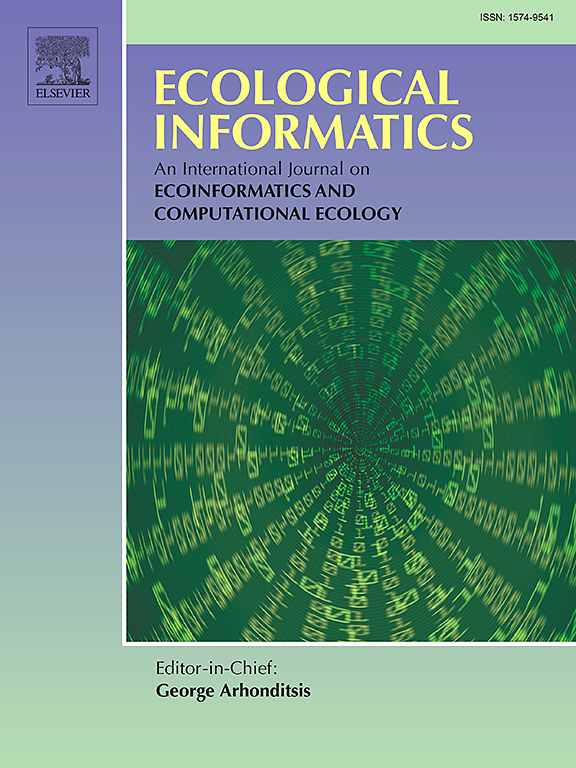Global soil respiration predictions with associated uncertainties from different spatio-temporal data subsets
IF 5.8
2区 环境科学与生态学
Q1 ECOLOGY
引用次数: 0
Abstract
Soil respiration (Rs), the second-largest flux in the global carbon cycle, is a crucial but uncertain component. To improve the understanding of global Rs, we constructed single global models, and specific models classified by climate type, land cover type, year of the data record, and elevation range using the random forest algorithm to predict global Rs values and explore the associated uncertainty in the models. The results showed a similar overall predictive performance for the models, with an R-squared value greater than 0.63; however, significant differences were observed compared to the global Rs estimate (23 Pg C). All the models estimated larger values of Rs than the single global model, mainly owing to imbalances in the sample data on which the prediction models were based. One exception to this result is the land cover model, which estimates a smaller global Rs for 2020 (95.1 Pg C). Overall, the single global model estimates were closer to those obtained for temperate zones owing to differences in the training data distribution, which resulted in smaller global estimates than those of other classification-specific models. Prediction models using observations before 2000 tend to underestimate the global Rs. However, the use of classification-specific Rs models proved helpful in addressing the persistent temporal and spatial imbalances in Rs sampling. Expanding the coverage of Rs records both temporally and spatially and updating the global Rs database promptly would improve the estimation accuracy of global Rs prediction models while enhancing the understanding of the overall global carbon budget and the feedback of soil carbon with regard to climate warming.利用不同时空数据子集预测全球土壤呼吸量及相关不确定性
土壤呼吸(Rs)是全球碳循环的第二大通量,是一个重要但不确定的组成部分。为了加深对全球 Rs 的了解,我们利用随机森林算法构建了单一的全球模型,以及按气候类型、土地覆被类型、数据记录年份和海拔范围分类的特定模型,以预测全球 Rs 值,并探索模型的相关不确定性。结果表明,各模型的总体预测性能相似,R 方值均大于 0.63;但是,与全球 Rs 估计值(23 Pg C)相比,发现了显著差异。所有模型估计的 Rs 值都大于单一全球模型,主要原因是预测模型所依据的样本数据不平衡。这一结果的一个例外是土地覆被模式,该模式估计的 2020 年全球 Rs 值较小 (95.1 Pg C)。总体而言,由于训练数据分布的差异,单一全球模式的估算值更接近温带模式的估算值,这导致全球估算值小于其他特定分类模式的估算值。使用 2000 年以前观测数据的预测模式往往会低估全球 Rs 值。然而,事实证明,使用特定分类 Rs 模式有助于解决 Rs 采样中持续存在的时空不平衡问题。从时间和空间上扩大 Rs 记录的覆盖范围并及时更新全球 Rs 数据库将提高全球 Rs 预测模型的估算精度,同时加深对全球碳预算以及土壤碳对气候变暖的反馈作用的理解。
本文章由计算机程序翻译,如有差异,请以英文原文为准。
求助全文
约1分钟内获得全文
求助全文
来源期刊

Ecological Informatics
环境科学-生态学
CiteScore
8.30
自引率
11.80%
发文量
346
审稿时长
46 days
期刊介绍:
The journal Ecological Informatics is devoted to the publication of high quality, peer-reviewed articles on all aspects of computational ecology, data science and biogeography. The scope of the journal takes into account the data-intensive nature of ecology, the growing capacity of information technology to access, harness and leverage complex data as well as the critical need for informing sustainable management in view of global environmental and climate change.
The nature of the journal is interdisciplinary at the crossover between ecology and informatics. It focuses on novel concepts and techniques for image- and genome-based monitoring and interpretation, sensor- and multimedia-based data acquisition, internet-based data archiving and sharing, data assimilation, modelling and prediction of ecological data.
 求助内容:
求助内容: 应助结果提醒方式:
应助结果提醒方式:


